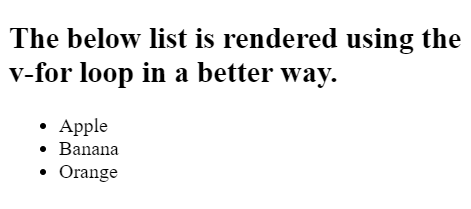
|
|
Vue.js is a popular JavaScript framework used for building dynamic web applications. One of its key features is the v-for directive, which allows developers to render a list of items based on an array or an object. Writing efficient and clean v-for loops is crucial for optimizing performance and maintaining readable code. You can utilize the below approaches to accomplish this task: Using Key AttributeAdding a unique key to each item in the v-for loop improves Vue’s rendering performance and helps in efficiently updating the DOM. Syntax:<ul> Example: The below code implements the key attribute to write better Vue v-for loops. Output:
Using Index VariableVue.js allows accessing the index of the current item directly within the v-for loop by passing and extra parameter to separately specify the index. Syntax<ul> Example: The below code implements index variable to use Vue v-for loop in a better way. Output:
Using v-for with Computed PropertiesSometimes you may need to filter or manipulate the data before rendering it. Computed properties can be used in conjunction with v-for to achieve this. Syntax:<ul> Example: The below code will explain the use of computed properties with v-for loop to use them in a better way. Output:
|
Reffered: https://www.geeksforgeeks.org
| JavaScript |
Type: | Geek |
Category: | Coding |
Sub Category: | Tutorial |
Uploaded by: | Admin |
Views: | 14 |

